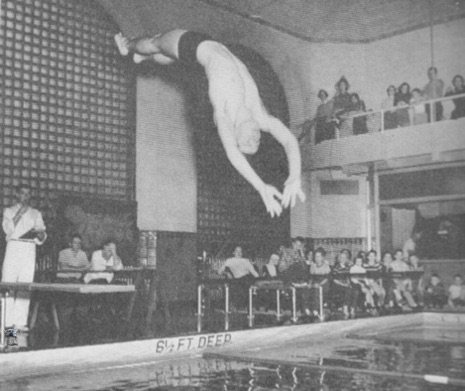Now Empty, Crane Pool Symbolizes Oberlin’s Progressive History

In the May 10, 2019 issue of The Oberlin Review, one might have noticed an unusual entry in the Security Notebook: “The south double doors to the vacant Crane pool area were ajar, and the master lock was pulled from the door. There was an odor consistent with burnt marijuana, and alcohol bottles were found throughout the area.” Similar break-ins also were reported in 2017 and 2018. However, most Oberlin students are likely unaware of the building referred to in the security report: the now-abandoned swimming pool languishing behind Hales Gym called Crane Pool.
Crane Pool was constructed in 1931 and was planned entirely for women’s needs. The pool was a $115,000 gift given by Mr. and Mrs. Winthrop Crane and their daughter Barbara, OC ’30, of Dalton, MA. The reason why the Crane family decided to donate money specifically for building a pool is unknown.
Crane’s construction occurred in a pre-Title-IX period when women were often characterized as having no interest in sports. Title IX was issued in 1972, addressing sex discrimination in institutions, including unequal opportunities for men and women’s athletic needs. Before Title IX, societal taboos and conservative ideologies discouraged women from pursuing athletics. Additionally, funding for women’s athletic programs was also significantly less than that allocated to men. In 1973, the average athletic budget received by women’s programs nationwide was only 2.1 percent of the total available athletic funding at Division I schools, while the men’s programs received the remaining 97.9 percent, according to a 1980 report by United States Commission on Civil Rights.
“Title IX provided the impetus for women to assert their right to an athletic program, and many of them did so as the number of women who participated in intercollegiate athletics soared from 16,000 in 1966–67 to 150,000 in 1983–84, a growth of nearly 1,000 percent,” Leland J. Brandt, OC ’92, wrote in his History honors thesis in 1992.
Though the College was progressive in providing space for women’s athletics, women’s team photos don’t show up on the team photo board on the wall of Philips Gym until the 1978 women’s swimming and diving team. If these teams did exist before then, they might not have been unofficial.
Eventually, after decades of use, the pool fell into disrepair as maintenance costs rose. Crane Pool was shut down in 1993 and used as an art space through 1998. As of today, there is no available record of the College’s plans for renovating the pool. Though the pool’s doors have been locked, it holds a special place in Oberlin’s athletic history.
By the 1960s, the pool was no longer exclusively used by the College. According to community members in a Facebook group facilitated by Executive Director of the Oberlin Heritage Center Liz Schultz, Crane Pool consisted of a small shallow instruction pool and a big pool. Children got excited when they were “promoted” to the big pool. Additionally, there was a balcony that didn’t seem to be too high, as people jumped from it directly into the pool. Everyone who responded to Schultz’s post expressed delightful memories of going to Crane as a kid. Respondents also recalled the heavy chlorine smell as well as how much they hated wearing the required rubber swimming caps.
Crane Pool’s role in physical education became less important when Philips gym and Carr Pool opened in 1971. By that point, Crane Pool had been used for almost 50 years, and its filter, pump, heater, and piping systems were all broken. The repair costs were expected to exceed $50,000, according to the Oct. 8, 1993 issue of the Review. The College ceased operating Crane as a swimming pool in 1993 because of a budget shortfall, according to The Observer.
After the shutdown, the building housing Crane Pool was soon transformed into an alternative art space. A 1998 Review article titled “Installation Works on the Rise” discussed the trend of installation art: projects encompassing a whole space while engaging with the audience. The article featured the installation “Womb Life” by Fereshteh Toosi OC ’98, a former art major.
Recalling her project today, Toosi said that her inspiration was mizuko kuyo, a Japanese ceremony for people who’ve gone through stillbirth, miscarriage, or abortion. Toosi wanted to “transform the entire pool into an altar space” by using materials such as clear plastic bags filled with red water on the floor of the pool, candles, and so on.
As the College was concerned about paint peeling from the ceiling, people visiting the installation had to wear safety helmets, according to Nanette Yannuzzi, professor of Studio Art, Installation, Sculpture and Book Arts, who also worked closely with Toosi. Yannuzzi wrote via email that, after the College hired its first in-house attorney, certain sites — such as Crane Pool — that were used for student art projects were closed off.
“This is an older building where asbestos and lead paint may have been used, so precautions for that need to be considered,” Chief Facilities Officer Kevin Brown wrote in an email to the Review. “The most important safety issue is that the pool is empty and anybody potentially [could fall] down into the pool.”
With those concerns in mind, Crane Pool is sealed off today. Toosi and other users of the space, however, remember it fondly.
“When a pool is filled with water, we experience it in a very different way,” Toosi said. “The lack of water and the fact that the pool was no longer in use connected to the themes of loss and memory.”


